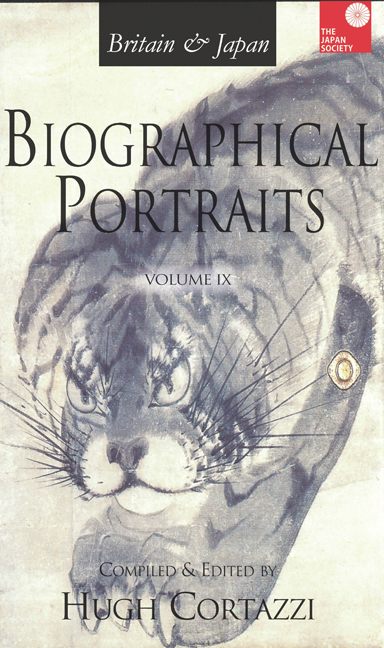Book contents
- Frontmatter
- Contents
- Introduction
- List of Contributors
- Index of Biographical Portraits in Japan Society Volumes
- PART I JAPAN IN BRITAIN: THINGS JAPANESE
- PART II BRITAIN IN JAPAN: TRADE
- BRITISH ACTIVITIES
- MISSIONARIES
- MUSIC, DRAMA AND FILM
- EPISODE
- PAINTERS
- JOURNALISTS
- JAPANESE WOMEN PIONEERS
- PART III SCHOLARS AND WRITERS: JAPANESE
- BRITISH
- PART IV POLITICIANS AND OFFICIALS: JAPANESE
- BRITISH OFFICERS
- BRITISH JUDGES AND A DIPLOMAT
- BRITISH POLITICAL FIGURES
- Index
15 - Christ Church, Yokohama, and its First Incumbent: Michael Buckworth Bailey, 1862–1872
Published online by Cambridge University Press: 30 April 2022
- Frontmatter
- Contents
- Introduction
- List of Contributors
- Index of Biographical Portraits in Japan Society Volumes
- PART I JAPAN IN BRITAIN: THINGS JAPANESE
- PART II BRITAIN IN JAPAN: TRADE
- BRITISH ACTIVITIES
- MISSIONARIES
- MUSIC, DRAMA AND FILM
- EPISODE
- PAINTERS
- JOURNALISTS
- JAPANESE WOMEN PIONEERS
- PART III SCHOLARS AND WRITERS: JAPANESE
- BRITISH
- PART IV POLITICIANS AND OFFICIALS: JAPANESE
- BRITISH OFFICERS
- BRITISH JUDGES AND A DIPLOMAT
- BRITISH POLITICAL FIGURES
- Index
Summary
INTRODUCTION
THE HISTORICAL RECORDS of Christ Church, the first Protestant Church in Yokohama, which opened its doors on 18 October 1863 at no. 105 in the treaty settlement, have suffered from natural and man-made disasters. The Church has stood on top of Yokohama Bluff across the road from the main entrance of the Yokohama Foreign General Cemetery since 1901. This paper investigates the first ten years or so in the life of this Church when Michael Buckworth Bailey (1827–1899), was the British Consular Chaplain from his arrival in Yokohama in the summer of 1862 to his departure in March 1872.
Bailey was a colourful, controversial and prickly character often at odds with other foreigners in Yokohama, but also a figure, flawed though he clearly was, who deserves greater recognition than he has received hitherto. Before discussing Bailey it is necessary to describe the efforts made to create Christ Church.
ESTABLISHMENT OF CHRIST CHURCH
As early as the spring of 1860 when Bishop George Smith (1815– 1871) of Victoria (Hong Kong) was visiting, the British community in Yokohama had held a meeting and found that they had sufficient funds both to build a church and to pay a clergyman £600. They had asked for Smith's help in obtaining ‘the usual assistance of [the British] Government’. Surprisingly, Smith did nothing to support this initiative. The real momentum for what would become Christ Church came at a public meeting chaired by William Keswick (1834–1912) of Jardine Matheson held on 28 August 1860, ‘to concert measures to obtain a place of public worship capable of accommodating the community of this Port’. A Yokohama Church committee was formed by Keswick and three others, which reported to a general meeting of the foreign community on 4 September 1860 that it was impossible to rent a suitable building and recommended the purchase of land in the New Concession and the building of a Church on it. Further, the committee thought, ‘the permanent requirements of the Settlement will be best met by the establishment of an Episcopal Chapel under the auspices of the Church of England and the British Government’.
- Type
- Chapter
- Information
- Britain & Japan Biographical Portraits Vol IX , pp. 173 - 184Publisher: Amsterdam University PressPrint publication year: 2015



